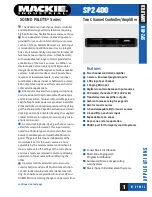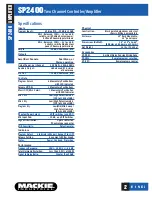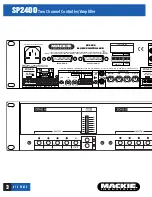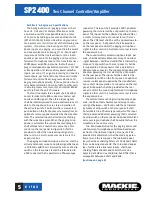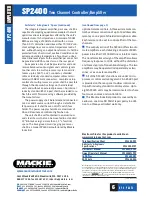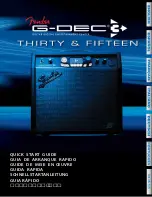
SP2400
Two Channel Controller/Amplifier
5
O F 6 P A G E S
connector. The input shall provide 24VDC phantom
powering that is selected by a dip switch on the rear
panel. The input shall be activated by either VOX or
a contact closure made at a connector on the rear
panel. The VOX level shall be set by a potentiometer
on the rear panel. A dip switch shall be provided
on the rear panel to direct the paging microphone
signal to other units in a multi-processor system via
the expansion bus.
The sound reinforcement microphone input, per
zone, shall be actively balanced, accept a nominal
signal between –52dB and +4dB that is trimmed by
means of a dip switch on the rear panel. It shall be
terminated in a XLR connector that is parallel to a
Phoenix-type connector. The input shall provide 24V
phantom powering that is selected by a dip switch
on the rear panel. The input shall be activated by
a momentary switch on the front panel, an optional
remote control panel supplied by the manufacturer,
or a contact closure made at a connector on the rear
panel. A dip switch shall be provided on the rear
panel to direct the sound reinforcement microphone
signal to other units in a multi-processor system via
the expansion bus.
The ambient noise sensing microphone input, per
zone, shall be actively balanced; and accept a nomi-
nal signal between –52dB and +4dB that is trimmed
by means of a dip switch on the rear panel. It shall
be terminated in a Phoenix-type connector. The input
shall provide 24V phantom powering that is selected
by a dip switch on the rear panel. An optional ambient
noise sensing microphone shall be available from the
manufacturer as an accessory.
Two-band equalization for the paging and sound
reinforcement microphones and three-band equal-
ization for the line level inputs per zone shall be
provided. All adjustments shall be made by poten-
tiometers on the rear panel. The two-band equal-
izers shall have shelving filters at 100Hz and 10kHz
that can be adjusted ±12dB. The three-band equal-
izer, for the stereo line level inputs, shall have
shelving filters at 80Hz and 12kHz that can be
adjusted ±12dB and a ±12dB mid-band filter that is
sweepable between 250Hz and 8kHz.
Architects’ & Engineers’ Specifications
The background music/paging processor shall
have UL, C-UL and CE safety certifications and be
a dual zone unit that is expandable up to a total
of 16 zones by adding up to seven additional units
(SP1200/SP2400) that can be either single or dual
zone processors. It shall consist of the following sub-
systems: (1) 4 stereo line level inputs, (2) 3 micro-
phone inputs, one paging, one sound reinforcement
and one ambient noise sensing,(3) a 3-band equal-
izer per zone for the line level inputs, (4) a 2-band
equalizer, per zone, for the paging and sound rein-
forcement microphone inputs, (5) a transformerless
200W power amplifier, per zone, that will accept
plug-in loudspeaker equalization modules, 70/100V
or 8
Ω
operation, (6) two auxiliary power amplifier
inputs, per zone, (7) a signal processing and two line
level outputs, per zone, (8) connectors and circuitry
for remote control of level, program selection and
paging microphone priority, (9) an expansion bus to
carry balanced audio and control data to other units
in a multi-processor system, (10) an internal RS485
port to re-flash the unit’s firmware.
The four line-level stereo inputs shall be unbal-
anced, terminated to RCA connectors and accept
nominal -10dB signals. The stereo input signals
shall be internally mixed to mono and remain avail-
able to the expansion bus in stereo. Selection of
the active input shall be from either a momentary
push button on the front panel or remotely from an
optional accessory panel provided by the manufac-
turer. The selected input shall allow cross fading
with the current program. When the paging micro-
phone is activated, the current line level program
shall attenuate to a level that is preset by a trim
control on the rear panel. A dip switch shall be
provided to direct the line level input signals to
other units in a multi-processor system via the
expansion bus.
The paging microphone input, per zone, shall be
actively balanced, accept a nominal signal between
–52dB and +4dB that is trimmed by means of a dip
switch on the rear panel. It shall be terminated in
a XLR connector that is parallel to a Phoenix-type
(continued on page 6)

